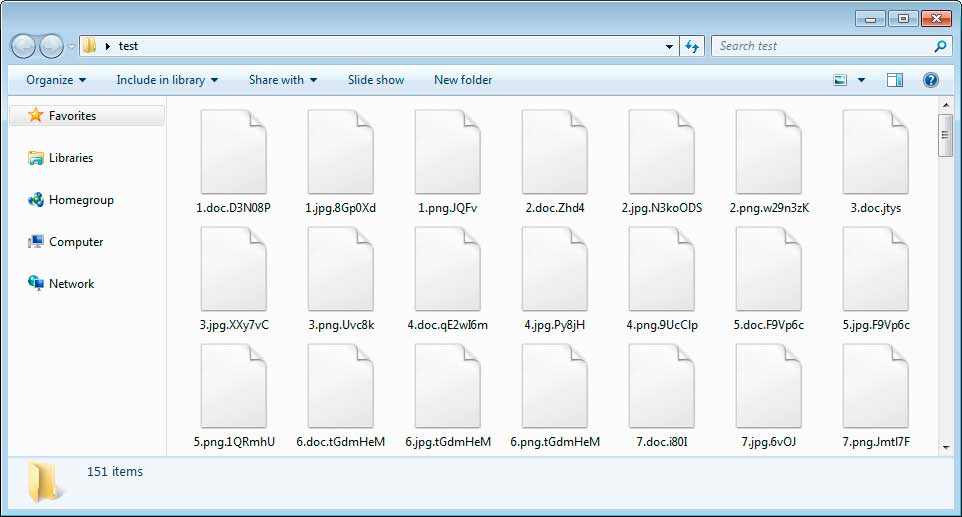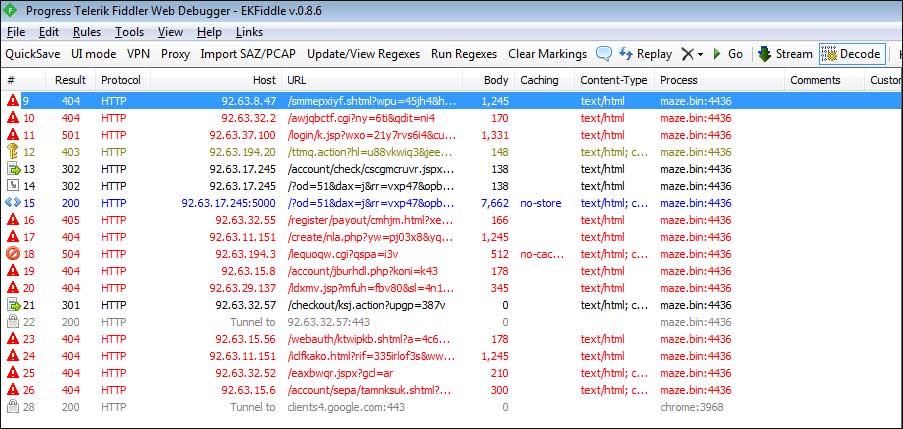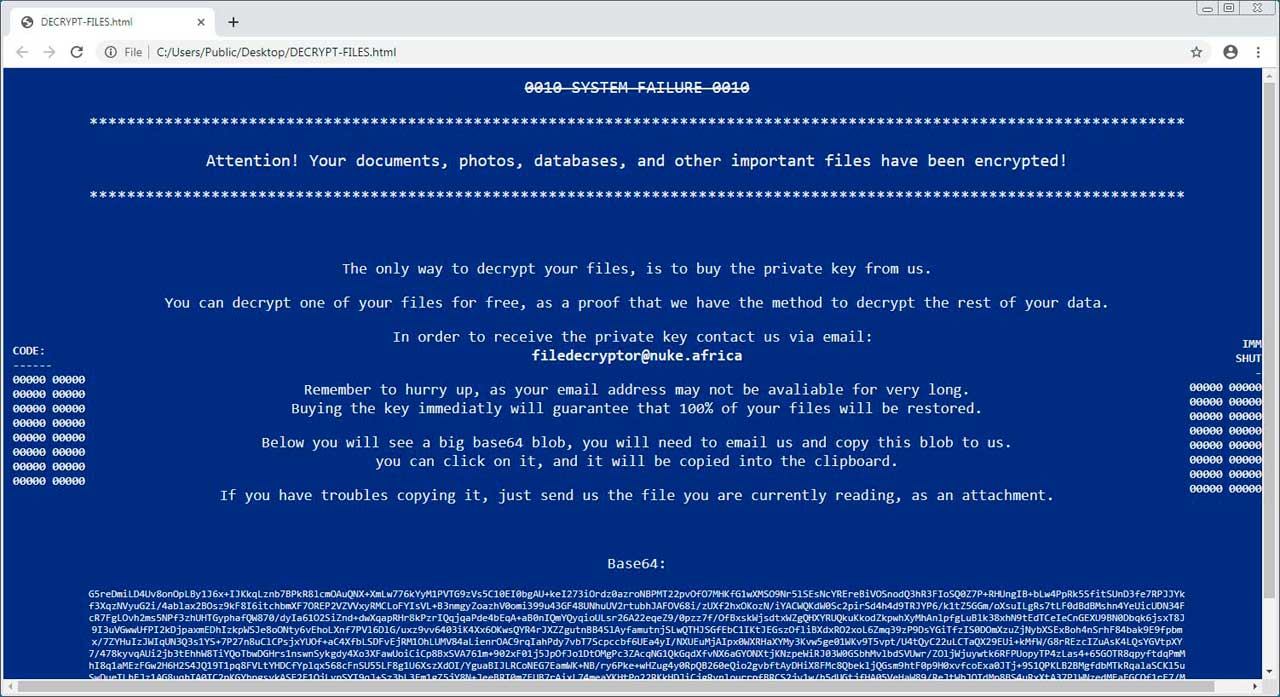
A variant of the Maze Ransomware, otherwise known as the ChaCha Ransomware, has been spotted being distributed by the Fallout exploit kit. An interesting feature of this ransomware is that it says the ransom amount will be different depending on whether the victim is a home computer, server, or workstation.
Malwarebytes security researcher Jérôme Segura discovered this ransomware being distributed by the Fallout exploit kit through a fake site pretending to be a cryptocurrency exchange app.
Segura told BleepingComputer that the attackers created a fake Abra cryptocurrency site in order to buy traffic from ad networks. Visitors to this site would then be redirected to the exploit kit landing page under certain conditions.
“The decoy site is used to pose as an advertiser and buy traffic from ad networks. From there, they can do conditional redirects towards the actual exploit kit landing page.”
The Maze Ransomware encryption process
According to Michael Gillespie, the Maze Ransomware utilizes RSA and ChaCha20 encryption as part of the encryption process.
“It generates an RSA pair on run, so the private of that is likely protected by a master RSA key, and the public is used to encrypt the ChaCha keys for individual files.”
When executed, the ransomware will scan for files to encrypt and append different extensions to the files as can be seen below.

While running, the ransomware will attempt to connect to 15 sites by their IP address, which all start with 92. When connecting it will use random URLs as shown below. It is not known if these are non-functional Command & Control servers or being used for another reason.

Strangely, when both I and Gillespie tested the malware, we saw the bleepingcomputer.com string in it’s memory. It is not known why it contains our domain name or how it is being used.

Finally, it will create a ransom note named DECRYPT-FILES.html that contains information on what happened to a victim’s files and an email to contact for payment instructions. This email is currently filedecryptor@nuke.africa.

At the bottom of the ransom note will be a Base64 string, which contains an encrypted private decryption key and information about your computer, such as the computer name, logged in user, version of Windows, and other information used by the ransomware. The ransom note states that this text must be sent when emailing the ransomware developer.
At this time, there is no way to decrypt the files for free.
Detects what type of computer is infected
An interesting feature of this ransomware is that it will try and detect whether the computer is a home computer, workstation, domain controller, server, etc and then states it changes the ransom amounts accordingly.
This will be shown in the desktop wallpaper, which will use one of the following strings to indicate the type of computer it is:
standalone server server in corporate network workstation in corporate network home computer primary domain controller backup server very valuable for youAn example of a Maze wallpaper on a machine detected as a home computer from an Any.Run session can be seen below.

How to protect yourself from the Maze Ransomware
In order to protect yourself from the Maze Ransomware, or from any ransomware, it is important that you use good computing habits and security software. First and foremost, you should always have a reliable and tested backup of your data that can be restored in the case of an emergency, such as a ransomware attack.
Because Maze is being installed via exploit kits, make sure you have all the latest Windows security updates installed and that your programs are updated to the latest versions. This will prevent exploit kits from using vulnerabilities to infect your computer.
As ransomware is also known to be installed via hacked Remote Desktop services, it is very important to make sure its locked down correctly. This includes making sure that no computers running remote desktop services are connected directly to the Internet. Instead place computers running remote desktop behind VPNs so that they are only accessible to those who have VPN accounts on your network.
It is also important to setup proper account lockout policies so that it makes it difficult for accounts to be brute forced over Remote Desktop Services.
You should also have security software that incorporates behavioral detections to combat ransomware and not just signature detections or heuristics. For example, Emsisoft Anti-Malware and Malwarebytes Anti-Malware both contain behavioral detection that can prevent many, if not most, ransomware infections from encrypting a computer.
Last, but not least, make sure you practice the following good online security habits, which in many cases are the most important steps of all:
- Backup, Backup, Backup!
- Do not open attachments if you do not know who sent them.
- Do not open attachments until you confirm that the person actually sent you them,
- Scan attachments with tools like VirusTotal.
- Make sure all Windows updates are installed as soon as they come out! Also make sure you update all programs, especially Java, Flash, and Adobe Reader. Older programs contain security vulnerabilities that are commonly exploited by malware distributors. Therefore it is important to keep them updated.
- Make sure you use have some sort of security software installed.
- Use hard passwords and never reuse the same password at multiple sites.
- If you are using Remote Desktop Services, do not connect it directly to the Internet. Instead make it accessibly only via a VPN.
For a complete guide on ransomware protection, you visit our How to Protect and Harden a Computer against Ransomware article.
IOCs:
Hashes:
e8a091a84dd2ea7ee429135ff48e9f48f7787637ccb79f6c3eb42f34588bc684Associated File Names:
DECRYPT-FILES.html %ProgramData%/foo.datNetwork Communication:
http://92.63.8.47 http://92.63.32.2 http://92.63.37.100 http://92.63.194.20 http://92.63.17.245 http://92.63.32.55 http://92.63.11.151 http://92.63.194.3 http://92.63.15.8 http://92.63.29.137 http://92.63.32.57 http://92.63.15.56 http://92.63.11.151 http://92.63.32.52 http://92.63.15.6Associated Email Addresses:
filedecryptor@nuke.africaRansom Note Text:
0010 SYSTEM FAILURE 0010 ********************************************************************************************************************* Attention! Your documents, photos, databases, and other important files have been encrypted! ********************************************************************************************************************* The only way to decrypt your files, is to buy the private key from us. You can decrypt one of your files for free, as a proof that we have the method to decrypt the rest of your data. In order to receive the private key contact us via email: filedecryptor@nuke.africa Remember to hurry up, as your email address may not be avaliable for very long. Buying the key immediatly will guarantee that 100% of your files will be restored. Below you will see a big base64 blob, you will need to email us and copy this blob to us. you can click on it, and it will be copied into the clipboard. If you have troubles copying it, just send us the file you are currently reading, as an attachment.Bleeping Computer® is a community of individuals of all ages who are here to learn new information, to help each other, and to help their fellow peers. With that in mind, we ask that all members please follow these simple rules in order to create an atmosphere where everyone feels comfortable.
The rules are as follows:
- All information and instructions given within these forums is to be used at your own risk. By following or using any of this information you give up the right to hold BleepingComputer.com liable for any damages.
- All the forums are categorized by topics. Please post your questions or messages in the appropriate forum.
- Answers to many of the questions you may have can be found in the Tutorials Section, Glossary, or from other posts on the message boards. Please use the search functions, at the top right of each page, to find your answers. If you are still having problems, feel free to post your question.
- All help must be provided in the forums or on our Discord Server. We do not allow support to be provided or requested via personal message, email, or remote desktop control programs (Logmein, TeamViewer, etc).
- If a topic is posted in a forum that is not appropriate for the question, the staff has the right to move that topic to another better suited forum.
- The posting of any copyrighted material on our web site is strictly prohibited.
- Posting links in order to generate affiliate commissions is not permitted at BleepingComputer.com. Any posts that are deemed to be posted in order to generate affiliate commissions, regardless of the product being promoted, will be deleted. If a user continues to create affiliate SPAM posts, they will be banned.
- Posting links to non-Bleeping Computer malware removal guides is NOT permitted with the exception of security vendors who sometimes release specialized tools and instructional documentation. This is because it is impractical for BleepingComputer to monitor and review all such guides for accuracy, no matter how accurate those guides may, in fact, be.
- There will be no use of profanity on our message boards. This will not be tolerated and can lead to immediate suspension.
- When posting, please use proper grammar. Refrain from ‘text-message’ style substitutions of words like ‘u’ for ‘you’, and ‘ur’ for ‘your’. This is a multi-national forum, and some of our non-english speaking members must use translation software which is confused by abbreviations. Most of our volunteer members are very busy helping as many people as they can, and a post that is hard to read will often be overlooked.
- There will be no racial, ethnic, gender based insults or any other personal discriminations. This will not be tolerated and can lead to immediate suspension.
- There will be no posts meant to offend or hurt any other member, in a manner which is offensive or inflammatory. This includes flaming or instigating arguments.
- Spamming is not permitted; please keep all your posts as constructive as possible.
- Pornography, warez, or any other illegal transactions may NOT be linked in any shape or form.
- If you have questions regarding homework, we will only help you with general concepts. If you are looking for a complete solution or answer, we will most likely just delete your post.
- No subject matter will be allowed whose purpose is to defeat existing copyright or security measures. If a user persists and/or the activity is obviously illegal the staff reserves the right to remove such content and/or ban the user. This would also mean encouraging the use or continued use of pirated software is not permitted, and subject to the same consequences.
- If you are receiving assistance in the Virus Removal forum, you are not allowed to request assistance for the same computer at another malware removal forum. This is to prevent conflicting advice from causing issues with your computer or making it unbootable.
- This forum has the right to request alteration or deletion of any offensive post. If this is not done in a prompt manner, the Staff will delete the material themselves.
- Posts may be deleted for any reasons the forum administrators deem reasonable.
- Pictures may be posted as long as they are not explicit, offensive, or copyrighted.
- Advertisements, of any sort, are not permitted. This includes member names and links to commercial sites in Signatures, or in posts. You also may not solicit sales for Newegg through the use of promotion or coupon codes. If you would like to advertise on our site, contact us here.
- In order to reduce spam on the site, you will not be able to add a signature to your account until you reach 25 posts. Signatures are limited to 5 lines or 2000 characters; whichever comes first. If your signature is larger than the allotted size given or deemed unacceptable, you will be requested to adjust your signature. Failure to comply will result in the removal of your signature.
- Only one image per signature. Images in signatures must also be no larger than 500 pixels wide X 90 pixels high. If you have more than one image you will be requested to remove one. If this is not done in a timely manner the staff has the right to modify your signature to abide by these rules.
- Any links in signatures or profiles cannot be commercial in nature or they will be removed by BleepingComputer. You may not put links in your signature soliciting donations unless you are in certain member groups. Those member groups that are allowed will be expressly notified. If you have a personal website or off-site help resource, that is more than fine, but you can not sell products or services through your signature. Multiple links to the same site, unless for a very specific reason, are not permitted in a signature and will be removed.
- Avatars must be in good taste. This means no vulgar or violent images, pornography, or profanity. Avatars that are found to be inappropriate will be removed at the discretion of the staff.
- Linking to hate, anti-Semitic, racist, pornography, warez, or other illegal sites is not permitted.
- Links in your signature must be unobtrusive and can not use formatting so that attention is brought to them.
- Member’s display names can not be email addresses. This rule is in place to protect you from spam bots who will pick up your email address and spam you.
- Members may have only one account on this forum. There is no need to have more than one.
- Any impersonation of a user from these forums, in any mode of communication, is strictly prohibited and will result in a banning.
- Linked and locked topics are pruned regularly to reduce page clutter. If you have a question about where your topic went, please PM a Moderator or Administrator before starting a new topic asking where it went, or posting a duplicate of the original topic. We will be happy to provide you with a link to the new location, or a reason why it was locked and/or removed.
Violation of any of these rules can lead to a banning of the user from our Web Site and a deletion of their account. The consequences will be determined by the Staff on a case by case basis.
When posting you agree that the administrators and the moderators of this forum have the right to modify, delete, edit or close any topic, signature, account, or profile data at any time that they see fit. If you have any questions concerning this, please do not start a new thread, but rather private message to an administrator or moderator.
